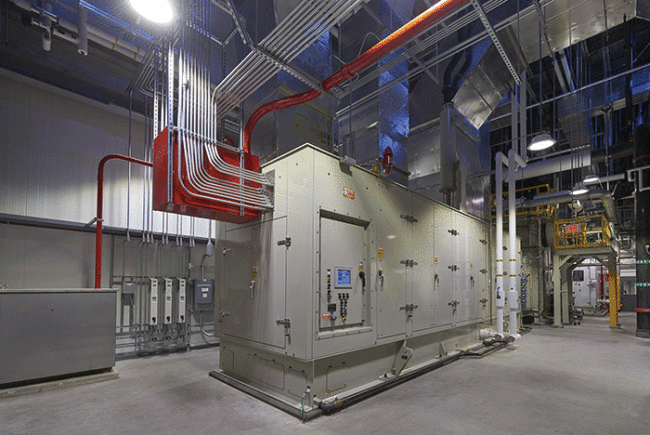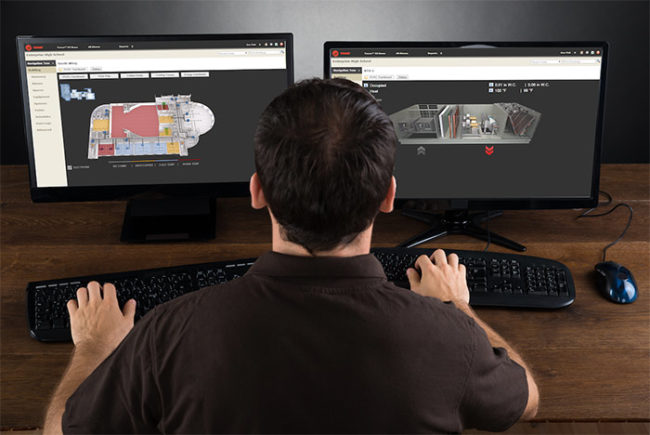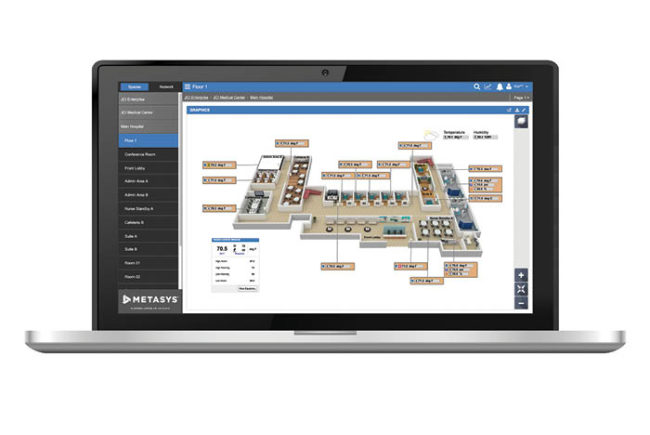The purpose of a building automation system (BAS) is much more than optimizing a building’s HVAC. The most advanced BAS enables monitoring and controlling a host of other building functions, including lighting, plug loads, access control, life safety and vertical circulation. They also provide facilities managers with crucial data that can improve operations and be accessed via graphic dashboards, tablets and smartphones.
“Building automation systems provide the tool set and connectivity to a great amount of data, advanced analytics and energy management,” says Jim Beam, controls sales leader, Trane, North America, Davidson, N.C. “For example, by using Trane Intelligent Services, hospitals can receive information to help them increase uptime of systems, decrease turnaround times in operating rooms, and improve comfort and efficiency,”
You may also like |
| Smarter building control integration |
| Wireless controls for building automation |
| Converging infrastructure technology systems |
| |
Trane offers graphic dashboards and interfaces that let users monitor and easily change setpoints from almost any Web- enabled computer, tablet or smartphone. These features make information more accessible and help facilities managers to make better decisions.
Local interfaces that allow operators to control certain aspects of their facility have made significant leaps in the past several years, according to Drew DePriest, CEM, LEED AP, Midwest regional sales manager, Automated Logic, Atlanta. “In a hospital setting, you might see such an interface outside pressurized spaces like operating rooms. Mounting an interface outside a pressurized room allows the operator to view conditions inside the space and make setpoint changes without physically entering the room.”
Automated Logic recently introduced two touch-screen devices, which use its Equipment Touch and System Touch interfaces. The Equipment Touch interface gives the operator access to a single zone and its respective HVAC equipment, whereas the System Touch interface integrates multiple zones into one device. They both benefit hospital facilities teams that are looking to increase performance in pressurized rooms.
Health care facilities managers are using custom dashboards to track environmental conditions, safety factors, equipment maintenance, energy usage, regulatory compliance and room occupancy for critical spaces, says David S. Grant, health care market manager, Honeywell Building Solutions, Minneapolis.
“This helps facilities personnel monitor and manage critical spaces such as operating rooms and isolation rooms. Also, hospital personnel are starting to use local monitoring devices similar to Phoenix Controls’ View and other mobile tablet solutions that display critical data such as temperature, humidity, and air changes per hour or pressure,” he notes.
Interoperability among systems is crucial to an energy-efficient building, according to Kevin Callahan, product owner and evangelist of Alerton’s Ascent control module (ACM). Based in Lynnwood, Wash., Alerton introduced ACM as part of its Ascent building management system, which incorporates BACnet protocol as well as Tridium’s Niagara Framework. The ACM’s interoperability includes critical systems monitoring in hospitals, such as environmental controls in labs.
The system’s Compass software is designed to reduce the number of steps required to complete a task. “For example, each user, or group of users, can configure the system to only present features pertaining to their work, which avoids the time and hassle of clicking past tools that are not applicable. Ease of use is crucial in BAS to ensure that the systems are used to their full potential,” Callahan says.
Bridging the gap
The newest building automation systems interact with hospital systems such as bed tracking, real-time locating and clinical systems, experts say. In fact, one of the key trends in the marketplace is bridging the gap between building automation and clinical systems, according to Anna Voldman, senior marketing manager of health care, Siemens Building Technologies Division, Buffalo Grove, Ill. Not only does this help facilities managers, it also provides a more comfortable environment for patients.
“For example, integrating the admission, discharge and transfer system into the BAS allows for energy conservation when the patient is discharged and the room is unoccupied for a certain number of hours each day. Similarly, integrating the BAS into the room infotainment system and pillow speakers from the nurse call system allows patients to control the room environment from the bedside,” Voldman explains.
“An additional opportunity exists to integrate operating room (OR) scheduling into the BAS,” Voldman continues. “This could reduce air changes per hour when the OR is unoccupied — saving energy and meeting surgeons’ specific requirements for room parameters.”
The true benefit of a BAS is realized when it is integrated with clinical systems, allowing staff and patients to control their own environments, adds Renee Jacobs, health care director, Johnson Controls, Milwaukee. In fact, the company already has integrated its Metasys BAS with surgery scheduling.
Integrating Metasys with surgery and patient room scheduling helps to ensure optimal patient outcomes; lower energy consumption by reducing air changes in the room when not in use; and improve continuous pressure relationship validation, Jacobs explains. Also, the new Metasys user interface provides instant access from any device, and helps users to troubleshoot critical issues quickly. This allows users to view alarms and changes to the BAS, regardless of physical location within the hospital campus.
Energy into data
Recent BAS advances are a boon to hospital energy management. It’s typical for the BAS to collect information about how HVAC equipment and building systems are using energy, according to Beam. “We’re doing more monitoring of energy data on a unit-by-unit basis, so it’s specific for each piece of equipment. Also, many acute care hospital facilities have large chiller plants, and numerous critical areas in the hospital are fed by the chiller plant. Collecting data that help to maintain the efficiency and uptime of that equipment is critical.”
Integration into the admission discharge and transfer system for energy setback is a huge driver of hospital energy management, says Warren Rosebraugh, director of health care solutions, Schneider Electric, Andover, Mass. The other big item is data analytics — capturing data and running analytics against that data to gain actionable insights.
“Through analytics, we now have the ability to tell the story from two perspectives: the energy side and the comfort/patient satisfaction side,” Rosebraugh says. “This data can provide feedback to facilities managers on what is not working properly and how much it’s costing the facility. The data can provide a prediction of how a damaged system is potentially impacting overall patient comfort.”
Wireless possibilities
As wireless becomes more affordable and more wireless devices are introduced to the market, hospitals eventually will be less reliant on a wired infrastructure. Some of the wireless benefits will include better tracking of such critical assets as beds and IV pumps, or hospital personnel, to be able to identify and determine where they are within a hospital.
Schneider Electric has developed wireless applications solely with the patient experience in mind, according to Rosebraugh. “Hospitals have existing Wi-Fi networks for patients and their families to use. We’ve built a smartphone application for patients to download these Wi-Fi networks to their own devices. They can then control everything in their room, including temperature and lighting, from that application.”
Wireless networks — both between sensor and controller as well as controller to controller — are becoming more common throughout the health care industry, according to DePriest. “Battery capacity, one of the disadvantages of a wireless BAS, stands to benefit greatly from the recent surge in demand for larger power storage systems. As we see electric utilities move toward a more distributed generation model, battery technology may see a period of rapid innovation and longer life.”
Managing remote facilities
BAS providers are aware of the trend toward hospitals’ owning a variety of facilities, such as medical practices, clinics, free-standing emergency departments and imaging centers, off the main campus. In fact, the latest BAS can maintain control of these remote sites.
Energy monitoring and fault detection are a necessity, regardless of the size and location of facilities. “The opportunity for setting back air handling units, turning off lights and reducing energy consumption during low or no occupancy times is much greater in outpatient and clinic environments. A BAS provides the tools to alter these settings when needed for extended or unscheduled use,” Jacobs says.
Outpatient facilities face similar challenges to those of hospitals, including the need for fire prevention, security and energy conservation, while controlling their costs, according to Dino Coliano, senior manager of health care national accounts, Siemens’ Building Technologies Division. “An enterprise-networked BAS can support the various types of building systems and equipment that a health care facility’s staff now supports. Different types of building controllers, sensors and meters can be installed to support all building types, large and small. All can be networked through BACnet protocols to the main BAS, wherever it resides.”
The Web accessibility, integrated dashboards and graphics available in BAS technology today can support the operation of multiple facilities in a large geographic area, according to Beam. “Scalable systems that are Web-accessible can be brought together on a single dashboard, so an owner or operator can look at multiple facilities even when they are hundreds of miles apart. They can actually see all of their facilities at once, and drill down into specifics as needed,” he says.
Having access to a simple graphical user interface can help hospitals to manage multiple facilities more efficiently across a wide geographical area, Grant agrees. “Some solutions, such as Honeywell's Command and Control Suite and the Command Wall, can display a hospital’s network of facilities across a visual map of their region. This graphical interface can enable operators to identify the problem area more quickly and to drill down into the issue by pulling up system information and incident workflow processes.”
As more remote facilities get tied into the main building’s BAS, one advantage of the Ascent system is its mobile access, says Callahan. “We built the system using HTML5, which enables facilities managers to access the Ascent BAS from any Internet-connected device, including tablets and smartphones. This enables them to access the BAS in the field, whether for routine equipment monitoring and adjustment, or for building commissioning and recommissioning.”
Looking ahead
With all these technological advances already in place, what does the future hold for building automation? “I see it becoming more interactive, and easier to integrate multiple systems and analyze what’s happening within all of them,” Beam predicts. “I also see energy analytics becoming more advanced. The adoption rate for BAS technology is much faster today than in the past.” HFM
Neal Lorenzi is a freelance writer based in Mundelein, Ill.
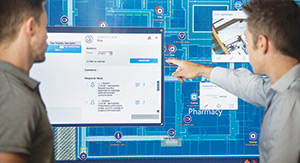 | Getting granularThe Command Wall’s intuitive, map-based, touch-screen visualization systems allow users to access an enterprisewide view and zoom into specific areas. |
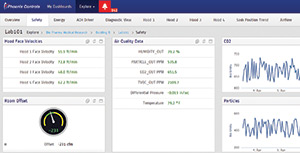 | Mobile monitoringThis mobile tablet solution gives easy access to such critical data as temperature, humidity and air changes per hour. |
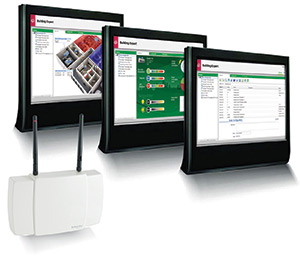 | Tight controlSmartStruxure Lite allows small- to medium-sized buildings to save time and energy while improving patient comfort. |
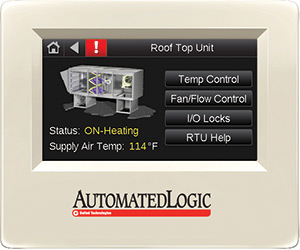 | In plain viewThis touch-screen interface shows full 3-D graphic representations of equipment. |
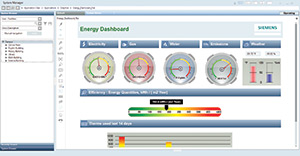 | Time and energyThe Energy Performance Dashboard provides a view for facilities managers to easily understand, manage and compare real-time energy consumption. |
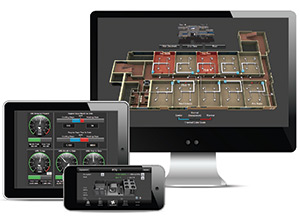 | Got it coveredBuilding automation systems that are Web-enabled can be monitored and managed from virtually anywhere — at any time — with a variety of devices. |
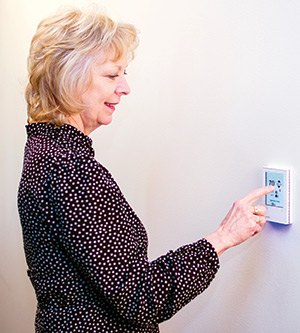 | Clinical communicationThe color LEDs of Microset 4 can be programmed to show dnovors and nurses, at a glance, if a surgical suite is properly postured. |



